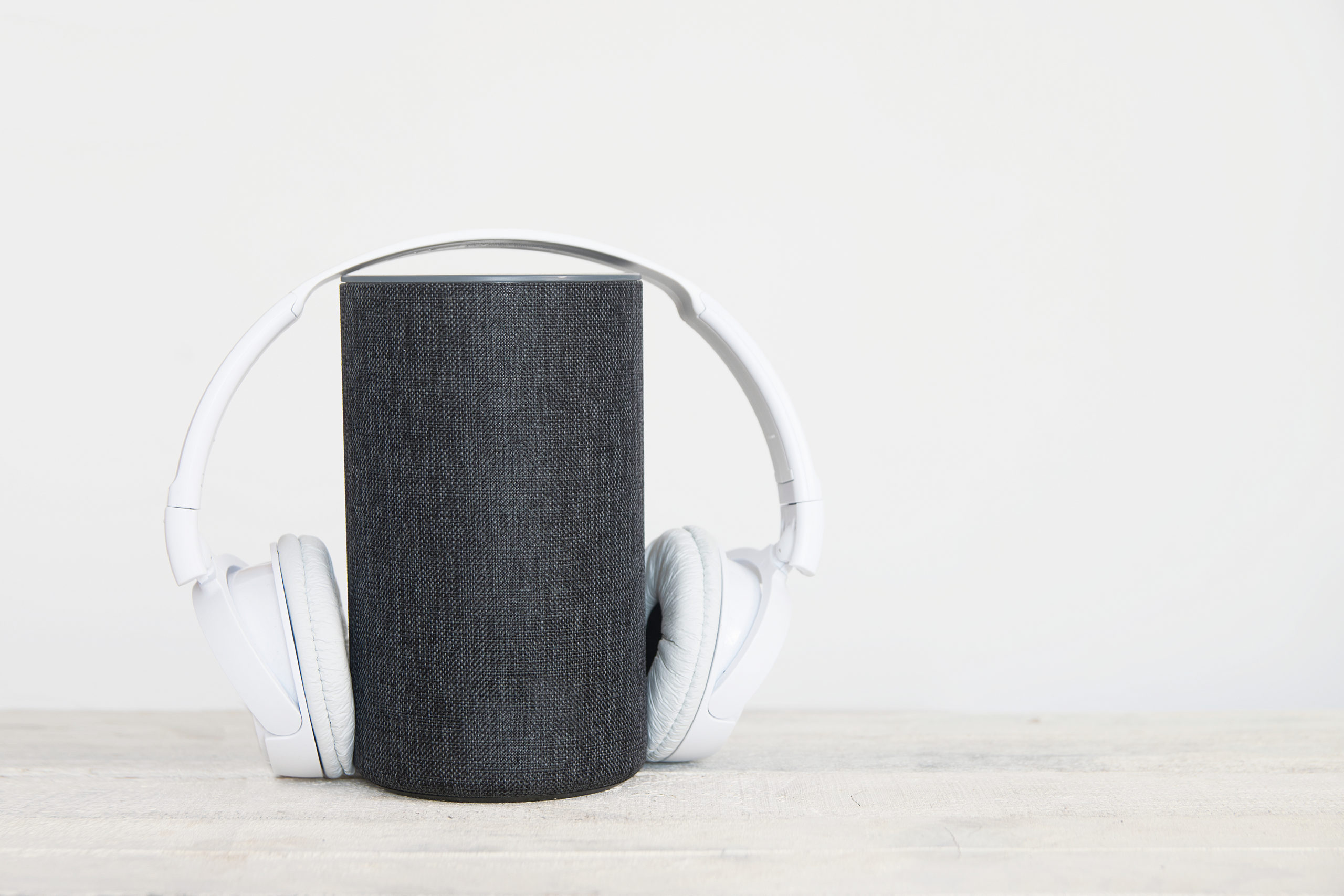
We’ve seen this one coming for a while. Like a slow moving ocean liner about to hit that iceberg, the sales of smart speakers have ground to nearly a trickle, confounding many experts who had predicted voice, largely driven by smart speakers, would rapidly replace search on a computer and mobile device keyboards.
In fact, devices like Apple’s Watch are now growing at a faster clip than smart speakers, an amazing data point. So, why the reversal of fortune for a technology that got off to a roaring start.
The data tell an amazing story. Techsurvey respondents knew all about the air going out of the growth balloon for both Amazon Alexa and Google Home devices. In the 2021 survey, we saw smart speakers hit the wall, after several years of rapid growth. In the early days when these devices were just coming to market, I referred to their trajectory as “iPhone growth.” We literally had not witnessed this level of customer acquisition since the iPhone, and before that, the iPod.
Looking at our most recent Techsurvey 2021, fielded last January and February, you can see why. Among our core radio listeners – pretty darn predictable of the overall population, by the way – smart speaker growth doubled in 2017-18. The increase continued more modestly the next year, and then the year after that.
And now in this year’s study, we’re showing that slightly more than one-third of our vast 40,000+ sample owns one of these devices, similar to our 2020 levels. But the growth spurt we witnessed just a few short years ago has cooled. In this year’s public radio version of Techsurvey, we’re also seeing the slowdown, despite heavy promotion by NPR and its member stations.

Last Friday, Inside Radio featured a story confirming this trend. In “Smart Speaker Market Growth May Have Peaked,” a new study by CivicScience is showcased.
The company conducts a tracking study. For the current quarter, more than 45,000 respondents participated. And the trends are clear: smart speakers are reaching a plateau. Now, we’ll see what holiday sales look like, but CivicScience matches the trajectory we’ve witnessed in Techsurvey.
Overall, their tracking study shows aa higher ownership – 39%. Still, the slowdown is consistent. In the nifty interactive chart (below), we can see how this looks generationally. Overall, they see flattening, with some potential growth coming from the youngest consumers.
The CivicScience study provides useful information on several fronts – how frequently smart speakers are used and by whom (yes, it skews young). It also turns out Amazon Prime members are significantly more apt to shop via Alexa. After all, that’s essentially why Amazon was interested in this technology in the first place.
So, what’s the impact of a smart speaker sales slowdown on broadcast radio? In Techsurvey this year, we learned the top “use case” among smart speaker owners is listening to a broadcast radio station.
And we know from our COVID tracking studies, conducted in three waves back in 2020, that smart speakers became a primary conduit for radio listening – especially in homes where there are no “regular radios.”
But why the obvious lack of momentum for this sector, especially at a time when consumer electronics have never been bigger. In the CivicScience study, that constitutes more than six in ten Americans who have not made the smart speaker plunge. In Techsurvey, it’s even more than that.
We were curious about why fewer consumers were willing to bring a smart speaker into their homes and places of work. So in our pre-pandemic Techsurvey 2020 (fielded in January and February – right before COVID), we asked those who had not purchased one of these devices to tell us the reason:
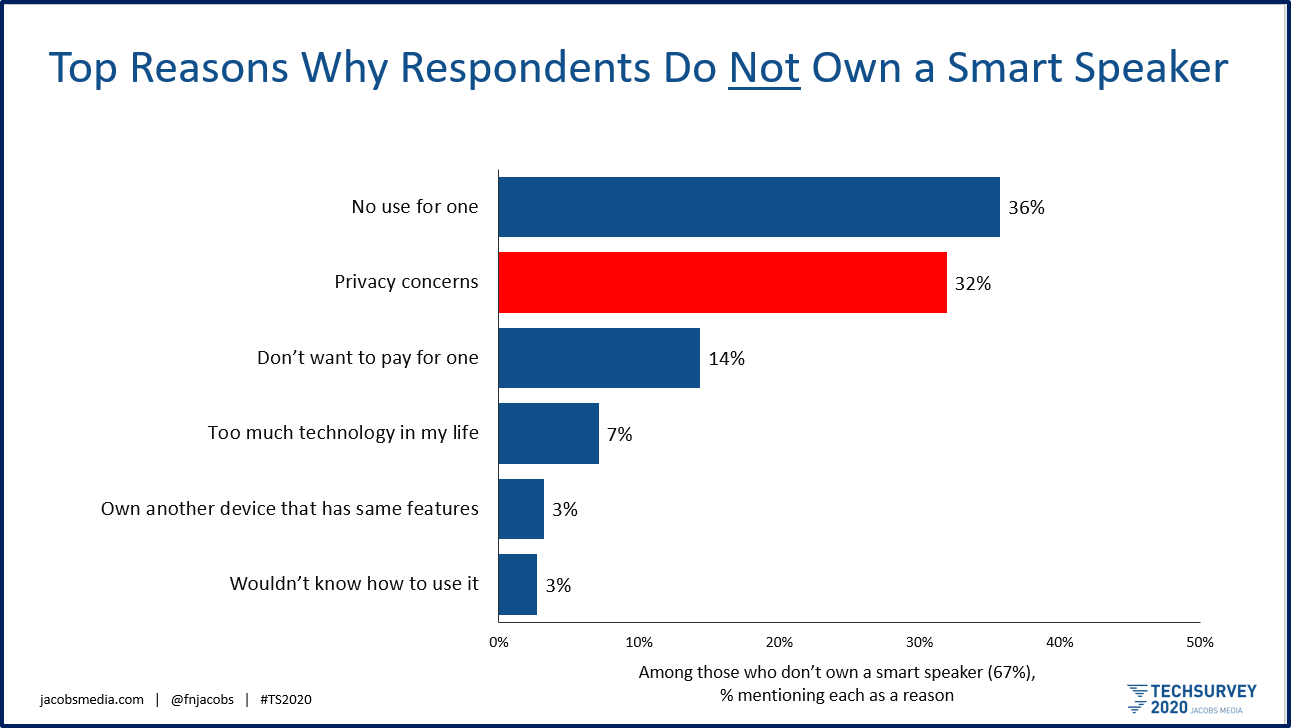
The top excuse – “no use for one” – can be a lot of things, from lack of knowledge of the technology to a simple rejection of these gadgets. But the second reason, mentioned by nearly one-third of those who don’t own a smart speaker, is more telling.
“Privacy concerns” has been a key stumbling block from the beginning. If you remember the early reviews and commentaries, especially on Amazon devices, there was this “it’s listening all the time” part of the devices’ narrative. In the scores of focus groups I’ve conducted since these devices first hit the market, I’ve heard the same trope:
“I’m not about to bring a device into my home that listens to my conversations.”
For smart speakers to become a true mass market success, this isn’t just a speed bump – it’s a core reason why millions have rejected the technology. And while Google and Apple have skillfully promoted their respective products, neither has adequately addressed this key barrier to ownership.
Of course, smart speakers DO listen to your conversation. So does your smartphone for those of us – that is, most of us – who give permission to opening its microphone. Same with your desktop, laptop, and your tablet. Your car is monitoring your voice commands, as well as tracking your locations and where you routinely shop, dine, work, and go to school.
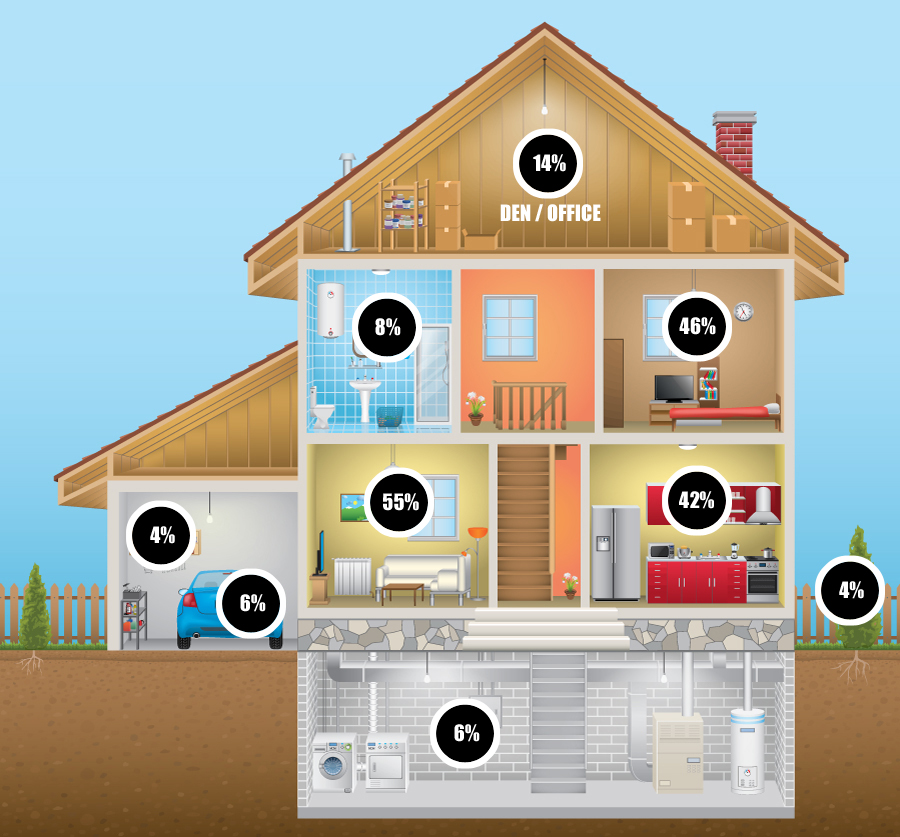
But even though smart speakers provide roughly the same utilities, and present similar privacy risks, conventional wisdom among the six in ten non-owners of Alexa or Google Home is wide-held and firm. Consumers simply do not trust these devices on dining room tables, bedrooms, kitchens, and dens.
While privacy concerns are real, it is essential for both Amazon and Google to address them at some point. Oddly enough, Apple has failed miserably in the smart speaker market – or let’s refer to it as “voice.” There was a time not that long ago where the first voice assistant many of interacted with was Siri. While “she” is still a popular voice assistant, Alexa rules, especially in the U.S. where Amazon has managed to maintain a huge lead.
But what if Apple rethought their progress with their HomePod line of products? What if they relaunched a new line of these devices that is truly different from the incumbents’ products?
After all, Apple didn’t invent the mp3 player, the smartphone, or the smart watch? Instead, they studied the existing players in these verticals, and used design, innovation, and the customer experience to build a a better mousetrap. Apple ended up creating the best in class in all three of these tech verticals, and then marketed them all brilliantly.
Maybe for Apple, the entry point to the smart speaker “drag race” is privacy. Imagine if Apple marketed its next line of these devices with the promise it would never “listen” to conversations – that the microphone on the new, improved HomePod is “off” until the consumer issues a voice command. Given Apple and Tim Cook’s penchant for mobile app privacy, this strategic angle could end up being a “steel sword.”
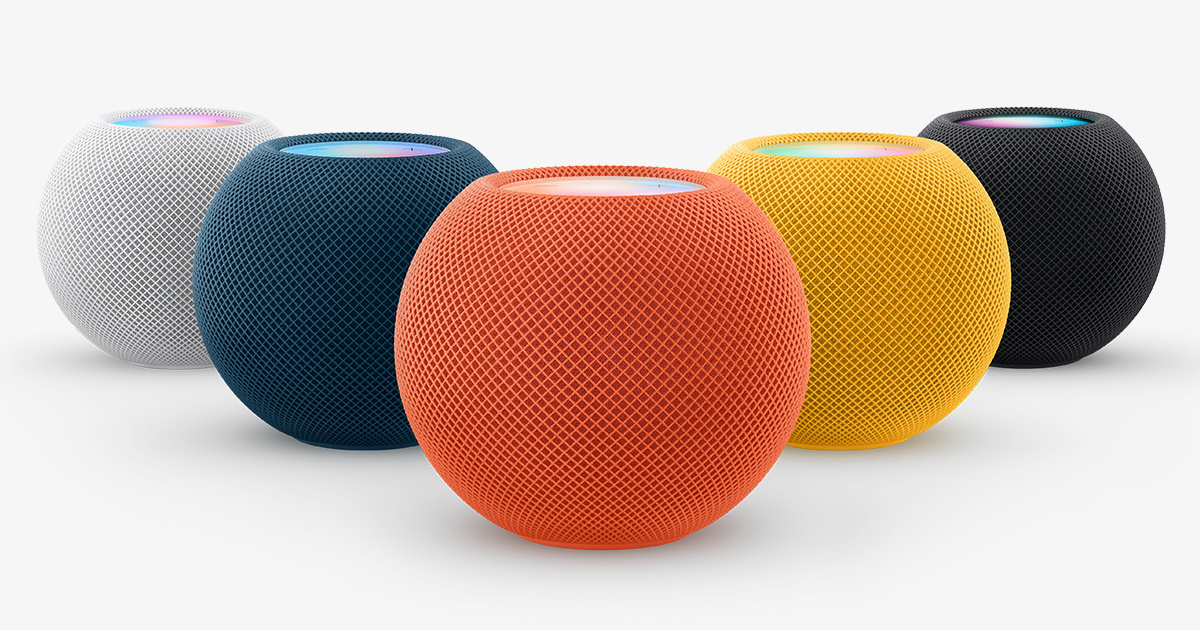
Perhaps the Cupertino crowd is getting more serious about their smart speaker division. Introduced last year, the Apple HomePod Mini (pictured) may be a step in the right direction. It comes in a number of cool colors, and is more competitive priced at $99. But Apple has not given consumers who have brought a smart speaker into their homes a reason to switch. Nor have they motivated their fan boys and girls to buy their version of the smart speaker.
And given how many homes are built with Google Home/Nest technology baked into new and remodeled homes, the longer Apple sits this one out, the harder it will be to become competitive in this space.
Why does any of this matter to radio? After all, the transmitters and towers are working fine. During COVID, in particular, millions of consumers learned how to stream on computers, tablets, and of course, their smartphones.
But many began to use smart speakers for streaming. Techsurvey 2021 shows the #2 “use case” of these devices is listening to broadcast stations (#1 is listening to DSPs, like Spotify and Pandora.) But in our Public Radio Techsurvey from this year, listening to a radio station on smart speakers is the top “use case.”
 We have continued to urge (OK, cajole) Jacobs Media clients, as well as all of you, about the importance of clearly promoting that a smart speaker is a radio. In fact, it’s easier to use. Stations can be discovered and tuned to with a simple voice command.
We have continued to urge (OK, cajole) Jacobs Media clients, as well as all of you, about the importance of clearly promoting that a smart speaker is a radio. In fact, it’s easier to use. Stations can be discovered and tuned to with a simple voice command.
And obviously, it is easy to switch stations by simply shouting out another command. Moreover, innovative broadcasters have developed “skills” that have embedded content you may not hear on their air, websites, or apps.
At the rate we’re going with COVID, it is impossible to predict just how long it will be until commuting patterns and routines return to a stronger, more consistent level. That means that for the foreseeable future, millions will be working from home, scraping together work in the gig economy, or retiring. In other words, they won’t be driving as much.
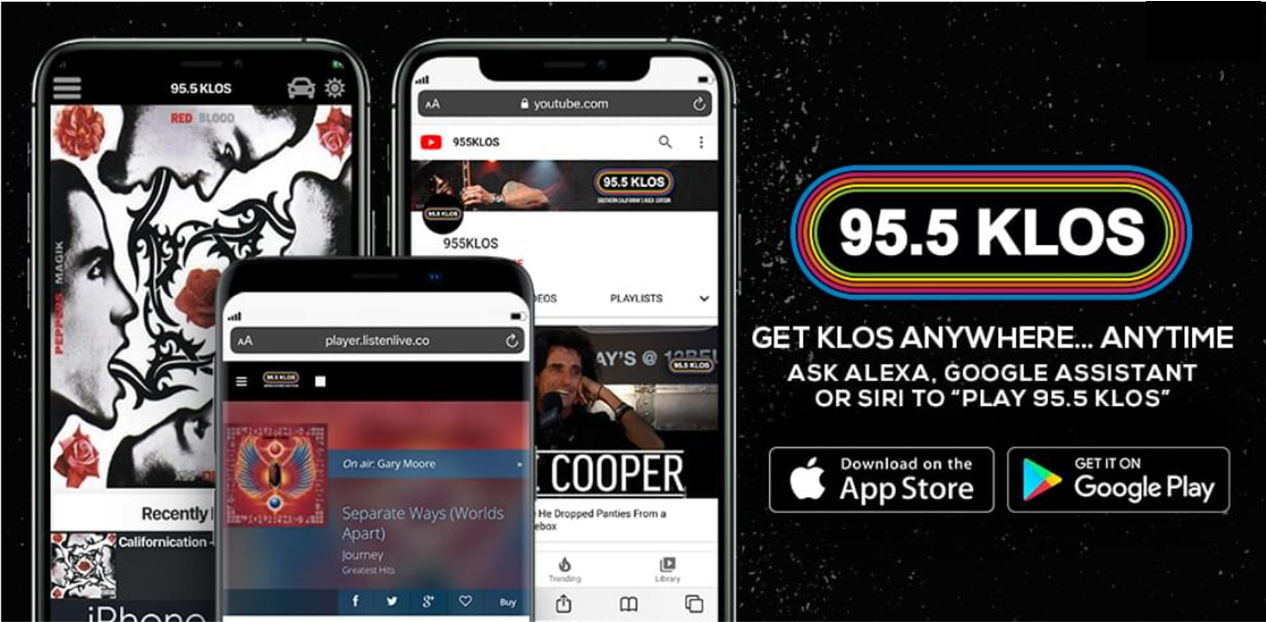 It is in broadcast radio’s best interest to promote the growth of smart speakers in any way, shape, or form. That might mean giving them away. Consumers aren’t likely to head to Best Buy to purchase a boom box. But they are far more likely to purchase an Amazon or Google smart speaker.
It is in broadcast radio’s best interest to promote the growth of smart speakers in any way, shape, or form. That might mean giving them away. Consumers aren’t likely to head to Best Buy to purchase a boom box. But they are far more likely to purchase an Amazon or Google smart speaker.
Broadcasters may not “own” this technology (Apple and Google make the rules), but the data show these devices are being used with increased frequency to listen to radio.
Helping the audience overcome the privacy issue, teaching them how to listen to your station, and reinforcing these devices are fun and easy to use could help the medium and its transition to digital.
And a Jacobs Media “pro tip” I’m more than happy to pass on. This is the time of year when Alexas, GoogleHomes, and maybe even HomePods will end up under a tree. December is a target rich month for promoting smart speakers with frequency, creativity, and enthusiasm. (It’s the same with mobile apps, as smartphones and tablets will continue to be popular gifts.)
- The Guy In The Next Car - May 6, 2025
- 5 Lessons For Radio From The Apple Watch - May 5, 2025
- DJs And Baristas: Can They Save Their Companies? - May 2, 2025




This is great insight. Thank you for another great article.
I appreciate the comment. Thanks for reading today’s post.
Alexa, Fred,
Is frankly largely deaf. When it comes to use of all of the competing platforms, Audacy and the others, Alexa is as dumb as the proverbial box of rocks. “Play Big 8 Radio” an online service, and she takes me to some obnoxious Big 98.7 from TuneIn. Epic fail. I ask for a song, and it’s often been resung, and remastered, badly, just to escape “Original Performance” issues. Subscription was very disappointing. And there is no qwerty keyboard to plug in the URL. “Go to the Alexa App.” Sorry, no, busy. Too many things show up in ads that are directly after a conversation in the kitchen. I mute with the red mic, but I am not entirely sure that I believe that that really disarms it. “If you’re concerned with what she hears, go into your online profile and delete them.” Yeah right. No thanks. This Canadian will take all three of these hockey pucks come January and wrist shot them into a dumpster. And stop with the endless suggestions on Amazon gift ideas. Also, note to radio stations that run an adjacent stream that is not your live station or morning show, you really need to inform people of your bait and switch, and do not ask me to sit through three, four or more commercials, some of which are exact repeats in the interest of adding “added value” for your clients, or curate them much more diligently. Smart devices, at least mine, are simply dumb, and the ai is not evolving other than to make a buck for Bezos. IMHO.
Ed Kelly
Thanks for these “tales from the front,” Ed. I subscribe to Amazon Music, and have been similarly disappointed by the lack of breadth, as well as Alexa’s tendency to pick a version of a song I don’t want to hear. You also point out other key problems with the interface, as well as how the product is being marketed. The technology is far from perfect, the user interface is often clunky, and the result can be frustrating.
But I do find that when the command is a simple one: “Alexa, play WCSX,” and it works, there is something there.
One last piece of advice: maybe sell those hockey pucks on eBay? You’ll probably get enough money to buy a Starbucks gift card.
Thanks, as always, for engaging here.
I’m not convinced smartspeaker use is all that significant…. for traditional broadcast radio listening. I believe most people use them for information seeking…. Who is playing on Monday Night Football? What’s the weather today, etc.? I’m certainly not convinced it has much relevance in small/rural markets such as mine. I’d love to know two things regarding this survey. 1. What were the questions. 2. Where do most of the respondents of this survey reside? Urban areas or in small town America? Like most of these “surveys” they are weighted more to large market/urban markets and do not accurately reflect small market (rural American’s) listening habits, in my humble opinion. I’ll also challenge one other point made in this column. In rural areas, again unlike metro markets, commute times never really decreased due to Covid, other than at the height when everything was shut down. Commute times in my market, as in most small markets, have not changed – there are no large amount of people working from home and radio listening continues to be done as it has for decades… mostly in the vehicle.
I appreciate the skepticism, Michael. You’re wise to question data, and its applications. I think you may be right that smaller markets may not be as applicable. But there’s one fact in this post that is inarguable: people are not buying radios. Therefore, any device that is mass market (or has the potential to be) that includes radio listening should be considered.
The fact that core radio listeners use these devices to listen to radio should reinforce their value. When the heaviest users and biggest fans of your station may be using them, why wouldn’t you lean into that?
Finally, a truism that radio must meet the audience where they are compels us to take the smart speaker phenomenon seriously. It may never be the leading way they listen, but even if it’s a tertiary avenue, it is worthy of us being openminded to its promise and potential.
Thanks for the thoughtful response.
I really have to agree with your reply to Michael’s thoughtful comments, Fred. In-car listening can actually lead to increased in-home listening, and these days, the easiest way to do that is through a smart speaker. I often get home and find myself interested in continuing to listen to what I was just listening to in the car. I walk through the front door, carrying more stuff than I care to put down and go find a radio to turn on, and simply tell Alexa to put on WZZZ–and on comes WZZZ–and I continue listening BECAUSE of the convenience and BECAUSE I was listening in the car. And I’ve told this to people only to hear them surprised to learn someone else does the same thing. People have these things. They’re convenient, easy-to-use…oh, and they usually sound much better than the radio you used to listen to. Even if only a third of people ever buy one, why wouldn’t you want to reach them?
Well said, Mr Manzi. Even I, a radio true-believer with an actual radio in nearly every room, use smart speakers sometimes. True, they were freebies that came to me when I bought something else, but I’ve found them useful–mainly for tuning in to radio stations beyond my antenna range, plus a couple of internet-only stations (eg, the excellent Radio Paradise). And, given their small size, the sound quality is remarkably decent.
Fred’s initial point is the primary item, though: Free pairs of ears that otherwise wouldn’t be listening to your station. What’s not to like?
David, your last sentence sums it up perfectly. Even if the growth of these devices is slowing down, millions have one. And there are many who enjoy these voice command devices. Why not make it easy for your audience to listen to your station when they’re within earshot of Alexa or the Google Assistant. Thanks for the comment and the observation.
Interesting as always, Fred, especially from the Techsurvey perspective. I’m not sure radio listening via smart speakers is so prevalent outside of the P1 Techsurvey cohort.
But never mind that. The smart speaker consumer electronics format might not be the important product point in the long run. I think we’re heading for a future when conversational AI is more granularly distributed, essentially everywhere, e.g. Starbucks drive-through where a massively sophisticated AI understands every nuance of the Starbucks menu and all the ways it can be articulated by a customer giving an order … and also incidentally eavesdrops on in-car conversations while still in earshot. Multiply that by AI listening in every purchasing and customer service environment, out-of-home and in-home.
I’m not a privacy alarmist; we’ve got four smart speakers in the house. And it is the only digital voice technology my radio-loving wife has ever adopted.
Cheers. 🙂
Brad, thanks for the perspective on smart speakers and radio. If you ask NPR, for example, you might be surprised how robust their smart speaker listening has become. (They have also marketed this outlet extensively and clearly.) I’m also beginning to believe that at this point, P1s may be radio’s best bet to get through this difficult period. We used to sweat how to convert P3s into P2s, and P2s into P1s. Now, it may be more about simply retaining those uber fans.
You are right about voice. Recognition has rapidly improved making it easier for the AI to figure out what we want. Good to hear your wife has embraced the technology.
Thanks for commenting on today’s post.
We’ve got 4 Alexa devices in my house, Fred.
Laundry room
Kitchen
Bedroom(2 of em, one on each nightstand).
My wife listens to the local AAA station and Howard on Sirius. My oldest son listens to Lithium station when in the kitchen. And I’ll tune into many of the stations I program at GotRadio.
But my youngest son?
Nope.
He wants no part of it. He’ll just continue walking around with earbuds, ignoring us all.
Those millennials!
Thanks for the info, Fred!
No argument from me, Bob, about the value of programming over all else. But if a radio listener is in a room with a smart speaker, and she wants to listen to her favorite station, it should be available to her. Or she’ll find something else to listen to. Thanks for the comment.
Each new generation of suits insists on tripping over their manhood. Software aka PROGRAMMING is the ONLY thing that has ever sold hardware!
I already listen to the radio on my computer, my car radio, or my iPhone. Tuning is trivial and the iphone works from voice too. Immersive audio is yet another huge mistake because most of the time, people do other stuff while they listen to music.
Bob, I am certainly a believer in content, better known as PROGRAMMING. But I also believe that if there’s another avenue available to listen to “radio” that can be mass appeal, broadcasters should jump at the chance to make use of it. When consumers invest – money or time – into a new outlet, be it a gadget, a social media platform, or something else, they have an expectation their favorite radio station should be there. If not, they may find something else to listen to.
Given the percentage of those owning “regular radios” at home or work continues to decrease, embracing a new distribution outlet makes sense. If the programming is not up to snuff, consumers can vote with their feet.
Thanks for the comment.
This reminds me of Thanksgiving, when a friend dropped by and I was showing her my smart speaker. She jokingly said, “Ooh, aren’t you afraid she’s constantly listening in on all your conversations?” She laughed. I laughed. Alexa laughed.
Scary.